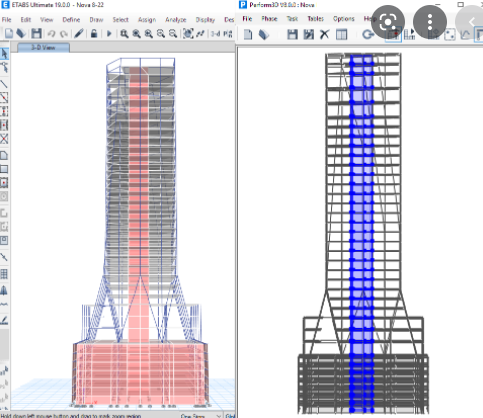The traditional approach to earthquake-resistant design was strength-based using linear elastic analysis. This is not always rational, as inelastic behavior can be allowed for strong earthquakes.
CSI Perform 3d
Password 123
Dr. Najam has over 10 years of experience in the analysis, modeling, and design of structures, including bridges, buildings, and other structures. In several countries, he has provided professional training to over 1000 people in the areas of structural analysis, design, and dynamic analysis. He is also involved in the design and development of software for structural engineering applications. These include structural detailing, earthquake-resistant design, and structural detailing. PERFORM-3D is a powerful tool for inelastic analysis. However, it is not designed for nonlinear general-purpose analysis.

The dislocation-based design recognizes that the deformation of inelastic structures in strong earthquakes is more important than the strength or force parameter. Perform 3D software also allows you to create earthquake-resistant structures using the displacement approach. Dr. Fawad A.Najam is currently Assistant Professor of Structural Engineering, NUST Institute of Civil Engineering, National University of Sciences and Technology, H-12 Islamabad (Pakistan). He holds a Doctor of Engineering in Structural Engineering degree from the Asian Institute of Technology Thailand. His research focuses on the evaluation and calculation of nonlinear seismic requirements of high-rise buildings through simplified analysis methods.
Perform3D’s limit state feature can be used to combine response data into demand/capacity ratios, which makes it easy to assess performance. Help to prove the topic’s notability by citing credible secondary sources that aren’t related to the topic and which provide substantial coverage beyond a trivial mention. If the notability of the topic cannot be demonstrated, the article will likely be merged, redirected, or deleted.
CSI Perform 3d Features
Displacement-based design (or deformation-based) considers inelastic behavior explicitly using nonlinear, inelastic analysis. The displacement-based design acknowledges that strength can be more important in strong earthquakes than inelastic destruction. Perform3D is a structural engineering software useful for the performance assessment of structural systems. State-of-the-art constitutive-modeling capabilities enable characterization of material nonlinearity, including strength and stiffness degradation during component-level hysteresis. Geometric nonlinearity and the effects of P-Delta behavior are also possible to be analyzed. Before evaluating the strength or deformation-based demand capacity ratio of components, they can be grouped by type, location, and limit state. Color-coordinated animations that display D-C usage are available.
F provides an intuitive and easy method to calculate elastic buckling using a Finite Strip Method and the modal visualization of a thin-walled structure element. The article could rely on too many sources that are closely related to the subject. This can prevent the article from being verifiable or neutral.
SAFE integrates all aspects of engineering design, from framing layout to detail drawing production. CSiCOL is a software package that allows for the design and analysis of columns. Perform3D, a tool that allows for nonlinear performance-based design and analysis, was created by Dr. Graham H. Powell (the University of California at Berkeley Professor Emeritus of Civil Engineering). A number of nonlinear components include frame hinges and shear walls as well as dampers, braces, and seismic isolators.
How to get CSI Perform 3d Free
This article might not be in compliance with Wikipedia’s guidelines for companies or organizations. CTICM developed EBPlate with partial funding from the European Research Fund for Coal and Steel. It evaluates the critical stresses that are associated with the elastic buckling plates loaded in their plans. LTBeam software deals with elastic Lateral Torsional Bulging of Beams in bending action around their major axis.
CSiCOLWebsitecsiamerica.comComputers and Structures, Inc. is a structural and earthquake engineering software company founded in and based in Walnut Creek, California with an additional office location in New York. CSiBridge is a structural analysis and design program that CSI produces. It also includes CSiBridge and ETABS. SAFE, PERFORM-3D and CSiCOL. Perform3D has many tools that allow you to measure the model’s response and assess the structure’s behavior, such as strain gage elements, deformation, and strength capacities on elastic and inelastic parts. Perform3D is a product that allows for nonlinear analysis and design. It is focused on capacity and displacement-based design. This video lecture series will focus on Performance-based Seismic Analysis of Buildings with PERFORM 3D. This series will show how PERFORM 3D can be used for nonlinear modeling, analysis, and optimization of buildings structures.
This software is compliant with ASCE 41 regarding building improvement. However, it does not exclude other regulations. Perform 3D is a complete software program for designing displacement-based buildings. Perform 3D is a summary non-linear software that allows for the analysis and study of earthquake-resistant buildings. It was created by Computers and Structures. Their job is to create software related to earthquakes and structures. New regulations regarding the strength of structures are now based on displacement.
His interests include seismic risk assessment and vulnerability assessment, earthquake engineering, structural dynamics, and seismic performance evaluation of tall buildings. It is difficult to predict how a structure will react to earthquake ground motion.
Capacity design can be used to control the behavior of a structure’s response to a strong earthquake. The capacity design allows for inelastic behavior in specific locations. This control of the behavior can improve reliability, reduce damage and reduce construction costs.
CSI Perform 3d System Requirements
- Memory (RAM): 2 GB of RAM required.
- Operating System: Windows XP/Vista/7/8/8.1/10
- Processor: Intel Core 2 Duo or later.
- Hard Disk Space: 200 MB of free space required.
